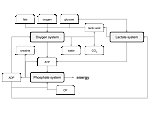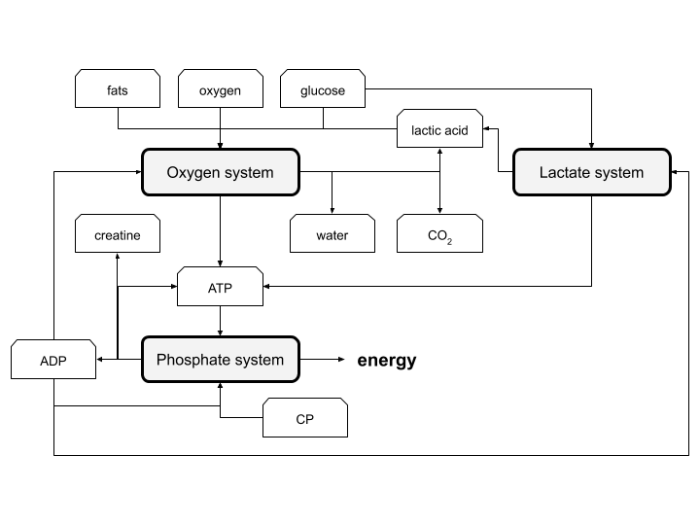1. Juni 2020
A computer scientist's diagram of the systems that turn macronutrients into energy for the muscles
 How do the macronutrients we eat─carbs, fat and protein─turn into energy that the muscles can use as fuel? How to answer this question without failing to see the forest for the trees? In this post, I am trying myself at a high-level abstraction based on the book Lactate Threshold Training by Peter Janssen.
How do the macronutrients we eat─carbs, fat and protein─turn into energy that the muscles can use as fuel? How to answer this question without failing to see the forest for the trees? In this post, I am trying myself at a high-level abstraction based on the book Lactate Threshold Training by Peter Janssen.
If you are a hobby athlete like me, or just generally curious, but haven’t studied biology or similar, then understanding how the muscles turn fuel into motion is a daunting challenge. The metabolism in the human body is dazzlingly complex. There is a long chain of mechanisms involved in breaking down your breakfast sandwich and turn it into energy of a form that the muscles can use.
I cannot understand all of the details with the time I have, yet I want to out how the muscles make use of the carbs stored intermediately in liver and muscles as well as the fats stored long-term in adipose tissue. I want to know what makes my muscles feel tired during exercise. I want to know when my body prefers fat as fuel, an when it prefers carbohydrates. There are a lot of interesting questions to ask. But I need a model at an adequate level of abstraction, which I can make sense of the information that is ubiquitously available on the world wide web.
The best model for this purpose I found in the book Lactate Threshold Training by Peter Janssen (https://g.co/kgs/CwVT7y )─with special thanks to the dear person who gave me the book in the first place! I am well aware that “all models are wrong, but some are useful” (George E. P. Box), or in a weaker form of this statement, that all models compromise in some senses. But that’s how you avoid not seeing the forest for the trees.
The book explains the process of turning macronutrients into energy for the muscles by describing the three energy systems involved. First, the phosphate system which releases energy by breaking down ATP (adenosine triphosphate) into ADP (adenosine diphosphate) with ATP being a currency very much at the top of the hierarchy of money (think, almost the ultimate currency when it comes to fuelling muscles). Second, the oxygen system which produces ATP with use of oxygen until the intensity of the exercise reaches a level where lactic acid builds up. Third, the lactate system which produces ATP without the need of oxygen. For the details, I refer you to more authoritative sources than this blog post, including the book itself─or the endless wisdom of the WWW if you happen to look in the right spots.

In the above diagram, I am taking the liberty to abstract from the reactions that underpin the metabolism I am just drawing the inputs and the outputs for each of the three systems. The energy for the muscles, as shown in this model, is supplied by the phosphate system by taking in ATP and breaking it down into ADP.
The diagram is obviously only showing part of the whole picture, but it has been helpful for me to put new information into the right place. I hope it may prove useful to you, too. And remember that I am a computer scientist dabbling in fields I am just learning, though you learn best when passing on the little knowledge you have gained to others. May this inspire you to go forth and explore the endless wonders of life!